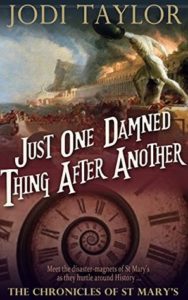Here’s a cure for excessively serious or positively ponderous. In Just One Damned Thing After Another, Jodi Taylor took a premise that’s been used numerous times before — history as a practical academic discipline, aided and abetted by time travel — and simply wrote the hell out of it. St. Mary’s Institute of Historical Research is an out of the way annex of Thirsk University, somewhere in the UK, and they definitely do not do time travel. As the director puts it, “We investigate major historical events in contemporary time.” (p. 11, emphasis in the original) And the first-person narrator, Dr. Madeleine Maxwell, thinks to herself, “Put like that, of course, it all made perfect sense.”
That handwaving is as close as Taylor gets to explaining how the historians’ traveling machines work, which is to say not at all. She doesn’t care, because this isn’t the kind of book that looks at physics too closely, or carefully examines the implications of a technology that allows transportation through time and space, or that charts in exquisite detail the consequences of undertaking numerous hazardous missions with high casualty rates. This is the kind of book that in just over three hundred pages sends its major characters to the Western Front of World War I, to an unknown but predator-filled location in the Mesozoic, and to the very flames of the Library at Alexandria.
Maxwell has an unhappy family history that is never explained, but which leaves her unattached in the present; she has advanced training in history and archeology, which give her the skills and mindset for a hands-on approach to history. Together, they produce a devil-may-care approach that suits the book’s madcap pace. Then there’s her penchant for risk-taking or, as she puts it in her internal narration of a most unusual job interview, “Thinking carefully is something that happens to other people.” (p. 10)
While many laws of physics are waved away for the sake of the story, there is something of a law of conservation of history. Or History, as the director of St. Mary’s puts it.
“Think of History as a living organism, with its own defence mechanisms. History will not permit anything to change events that have already taken place. If History thinks, even for one moment, then it will, without hesitation, eliminate the threatening virus. Or historian, as we like to call them.” (p. 12)
So there’s dangerous but exciting work. Naturally there’s a team of people eager to do it, and a supporting cast that’s also full of quirks and striking personalities. The security team is particularly striking, but usually give fair warning when they are about to do it.
The new historians are put through rigorous training before they can be trusted to accompany more senior members on any missions.
Wednesday was [the] Self-Defence [examination]. I made no headway at all with Weasel as he none too gently chucked me around all over the place, grinning his stupid head off all the time. I waited until a particularly heavy fall then placed my hand on my lower stomach, curled into a ball and uttered, ‘Oh God, the baby!’
Weasel stopped dead, saying ‘What …?’ and I hacked his legs out from underneath him, leaped to my feet, ran across his chest, and rang the bell, which was the whole point of the exercise. Weasel shot me a filthy look and, at this point, there was no scribbling [on the examiners’ clipboards] at all. Major Guthrie threw down his clipboard and walked off.
‘Oh dear,’ I said to a watching Murdoch.
‘No, you’re OK. He’s gone round the corner where no one can see him laugh.’ (pp. 32–33)
The pace isn’t much slower anywhere in the book, and it’s so full of life that it’s a joy to read from start to finish. Plus it’s a cracking good adventure story because not only does History itself resent intruders from one part in another, the Institute has enemies within the University (disproving the old adage about stakes being low in academic politics), and not everyone within the Institute is a reliable as they first appear. Taylor pulled out all the stops, but, improbably, there are now at least six sequels in the chronicles of St. Mary’s. One damned thing after another.


1 pings
[…] can see the contemporaries making great haste to higher ground — bring a quotation from the very first St Mary’s book back to mind. “Think of History as a living organism, with its own defence mechanisms. […]